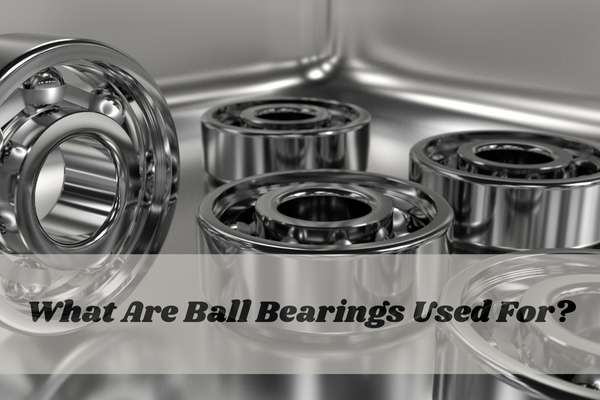
Ball bearings are essential mechanical components used to reduce friction and facilitate smooth rotational motion in various applications. Their primary function is to support radial and axial loads while ensuring minimal energy loss due to friction. Made from durable materials such as stainless steel, ceramic, or hybrid compositions, ball bearings are widely employed across multiple industries, from automotive to aerospace, manufacturing, medical equipment, and beyond. Let’s explore their uses in detail.
The automotive sector relies heavily on ball bearings for various functions, ensuring the smooth operation of vehicles by reducing friction in moving parts.
Wheel bearings are crucial in automobiles, allowing the wheels to spin with minimal resistance. They provide stability, reduce wear and tear, and ensure safety while driving. These bearings support both radial and axial loads, making them indispensable for a vehicle’s performance.
Ball bearings in the transmission system help transfer power efficiently from the engine to the wheels. They minimize friction between rotating shafts and ensure smooth gear shifting, leading to better performance and fuel efficiency.
Modern car engines incorporate ball bearings in components such as turbochargers, alternators, and cooling fans. These bearings help in reducing friction, increasing engine efficiency, and prolonging the lifespan of moving parts.
Ball bearings are present in the steering column to facilitate easy and smooth maneuverability. They help reduce driver effort while steering and contribute to a vehicle's overall handling performance.
In the aerospace sector, precision and reliability are paramount, making ball bearings an integral component of various aircraft systems.
Ball bearings in jet engines handle extreme speeds and temperatures. They ensure smooth rotation of the turbine shafts, thereby optimizing fuel consumption and improving the engine’s overall efficiency.
The landing gear assembly includes ball bearings to enable smooth retraction and extension. These bearings withstand high impact forces upon landing and ensure operational safety.
Aircraft require precise control over their aerodynamic surfaces, such as flaps and rudders. Ball bearings facilitate smooth motion in these components, enhancing maneuverability and stability.
Industrial applications heavily rely on ball bearings to maintain efficiency, reliability, and longevity in machinery and production systems.
Ball bearings help conveyor belts move smoothly by reducing friction between rollers and the belt itself. They enable uninterrupted movement of goods in manufacturing plants, warehouses, and distribution centers.
Industrial robots and automated systems depend on ball bearings to enable precise motion control. These bearings minimize energy losses and ensure high-speed, accurate movements required in manufacturing processes.
Motors and pumps in industries require ball bearings for efficient power transmission. Bearings reduce heat generation, extend operational life, and improve overall machine performance.
Medical devices require high-precision ball bearings to ensure smooth operation and longevity, especially in critical applications.
Ball bearings enable the smooth movement of scanning components in MRI and CT machines. The reduced friction ensures precise imaging, improving diagnostic accuracy.
High-speed dental drills use ball bearings to ensure smooth rotation, reducing vibration and improving patient comfort. These bearings must be durable, as they operate at extremely high speeds.
Minimally invasive surgical instruments incorporate ball bearings to enable precise movements during procedures. Their smooth operation ensures enhanced control for surgeons.
Ball bearings are also found in everyday household appliances, contributing to their efficiency and durability.
Bearings in washing machines and dryers reduce friction between moving parts, ensuring quiet operation and extending the appliance’s lifespan.
Fans and air conditioning units use ball bearings in their motors to ensure smooth and silent operation. These bearings help reduce wear and improve energy efficiency.
Ball bearings in refrigerators and freezers support the compressor motor, facilitating the cooling process while reducing noise levels.
Ball bearings are widely used in sports and recreational equipment to enhance performance and longevity.
Bicycles use ball bearings in wheel hubs, bottom brackets, and pedals to ensure smooth riding and efficient energy transfer from the cyclist to the wheels.
Ball bearings allow for effortless movement in skateboards and roller skates. High-quality bearings enhance speed, reduce friction, and improve durability.
Precision ball bearings in fishing reels provide smooth casting and retrieval, improving the angler's control and experience.
In construction and heavy industries, ball bearings are vital for maintaining the efficiency of massive machines and tools.
Ball bearings in cranes allow smooth movement of the lifting mechanisms, enabling them to handle heavy loads efficiently while reducing wear.
Construction equipment such as excavators and bulldozers incorporate ball bearings in their hydraulic systems to ensure efficient power transmission and movement.
Mining machinery uses ball bearings to endure extreme loads and harsh conditions. These bearings must be durable to withstand the high-stress environment of mining operations.
Ball bearings are essential in electronic and precision devices, ensuring smooth and accurate performance.
Hard drives use ball bearings to enable smooth spinning of the disk platters. They help maintain data integrity and prolong the lifespan of storage devices.
Precision ball bearings in camera lenses and optical devices allow smooth zooming and focusing, ensuring clear images and enhanced user experience.
Mechanical watches and clocks incorporate ball bearings to maintain accuracy and durability over extended periods.
Ball bearings are fundamental components in countless applications across industries. Their ability to reduce friction, support loads, and enhance efficiency makes them indispensable in automotive, aerospace, medical, manufacturing, and household applications. Whether enabling smooth movement in high-speed machinery or improving durability in household appliances, ball bearings play a crucial role in modern mechanical systems. Understanding their various applications helps engineers, manufacturers, and consumers appreciate their significance in daily life.